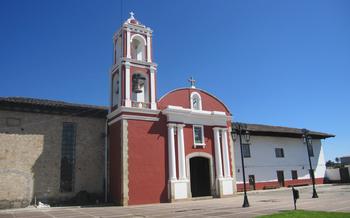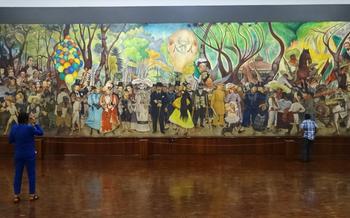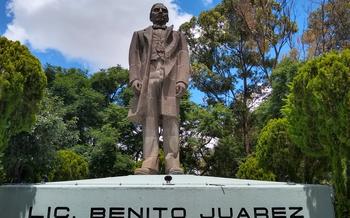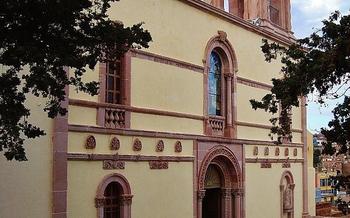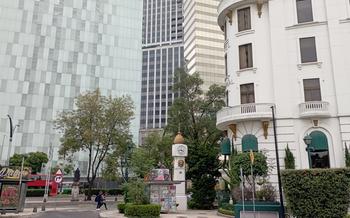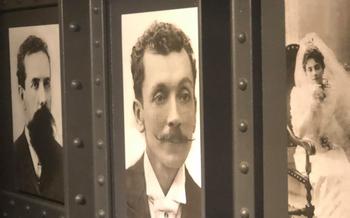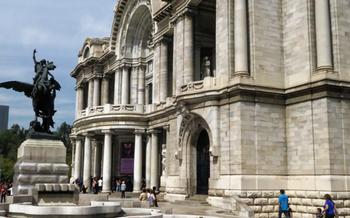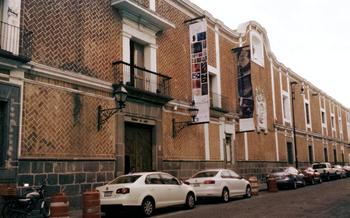
Museo de la Revolución Mexicana
- Museo de la Revolución Mexicana: A Journey Through Mexican History
- Location and Accessibility
- Museum Collection
- Interactive Exhibits
- Guided Tours
- Temporary Exhibitions
- Research Facilities
- Events and Activities
- Architecture and Design
- Accessibility for Disabled Visitors:
- Gift Shop and Souvenirs:
- Food and Dining Options:
- Photography and Videography:
- Insider Tip:
Museo de la Revolución Mexicana: A Journey Through Mexican History
Historical Significance:
The Museo de la Revolución Mexicana in Puebla, Mexico, stands as a testament to the nation's tumultuous past and the profound impact of the Mexican Revolution. This remarkable museum is dedicated to preserving and showcasing the events, people, and artifacts that shaped this pivotal era in Mexican history. Through its extensive collection of artifacts, documents, and exhibits, the museum offers visitors a comprehensive insight into the struggles, triumphs, and legacy of the Revolution.
The Mexican Revolution, which erupted in 1910 and lasted for over a decade, was a transformative period that redefined Mexico's political, social, and economic landscape. The museum's exhibits delve into the causes and consequences of the Revolution, exploring the grievances of the Mexican people against the dictatorship of Porfirio Díaz and the subsequent fight for justice, land, and democracy.
Location and Accessibility
The Museo de la Revolución Mexicana is conveniently located in the heart of Puebla, Mexico, at the intersection of Calle 11 Norte and Avenida Reforma. It is situated within easy walking distance of several other popular tourist destinations, including the Zócalo (main square), the Puebla Cathedral, and the Palacio Municipal (City Hall). The museum is wheelchair accessible and offers designated parking spaces for visitors with disabilities. Public transportation is readily available, with several bus routes stopping nearby. The museum's central location and excellent accessibility make it a convenient and enjoyable destination for visitors of all abilities.
Museum Collection
The Museo de la Revolución Mexicana boasts a diverse collection of artifacts, documents, and exhibits that provide a comprehensive overview of the Mexican Revolution. Notable items include weapons used by revolutionary figures, such as Emiliano Zapata's rifle and Pancho Villa's saber. Visitors can also see uniforms, personal belongings, and photographs that offer a glimpse into the lives of these iconic leaders and their followers. The museum also houses an extensive collection of documents, including letters, manifestos, and newspapers, that shed light on the political and social dynamics of the revolutionary era. These artifacts and documents are carefully organized and presented to enhance the visitor experience, creating a powerful narrative of the Mexican Revolution and its impact on the nation's history.
Interactive Exhibits
The Museo de la Revolución Mexicana captivates visitors with its array of interactive exhibits, transforming history into a tangible experience. Multimedia presentations bring to life the stories of revolutionary figures, immersing visitors in the tumultuous events that shaped Mexico's destiny. Touchscreens offer an in-depth exploration of key historical moments, allowing visitors to delve deeper into the causes and consequences of the Revolution. Hands-on activities, designed for visitors of all ages, provide a unique and engaging way to learn about the struggles and triumphs of this transformative period.
These interactive elements not only enhance the learning experience but also make the museum accessible to a broad audience, including families with children, students, and history enthusiasts. The museum's commitment to innovation and engagement ensures that visitors leave with a profound understanding of the Mexican Revolution and its lasting impact on the nation's identity.
Guided Tours
The Museo de la Revolución Mexicana offers guided tours to enhance the visitor experience and provide a deeper understanding of the Mexican Revolution. These tours are conducted by knowledgeable museum guides who share their insights and expertise on the historical significance of the exhibits. Visitors can choose from general admission tours that provide an overview of the museum's collection to specialized tours tailored to specific groups or educational tours designed for students. Guided tours allow visitors to ask questions, gain insights into the historical context of the Revolution, and appreciate the significance of the artifacts on display. Booking a guided tour in advance is recommended to ensure availability, especially for larger groups or during peak tourist seasons. Tours are available in Spanish and English, with other languages offered upon request.
Temporary Exhibitions
The Museo de la Revolución Mexicana hosts a dynamic program of temporary exhibitions that complement its permanent collection and offer visitors a fresh perspective on the Mexican Revolution and its legacy. These exhibitions explore various themes, showcase unique artifacts, and present innovative interpretations of historical events.
Past temporary exhibitions have covered topics such as the role of women in the Revolution, the impact of the Revolution on indigenous communities, and the cultural and artistic expressions of the revolutionary era. These exhibitions have featured rare photographs, personal belongings of revolutionary figures, and interactive displays that bring history to life.
Temporary exhibitions at the Museo de la Revolución Mexicana enrich the museum's offerings and provide visitors with a diverse and engaging experience. They allow the museum to delve deeper into specific aspects of the Revolution, present new research and perspectives, and engage with contemporary issues and debates related to Mexican history.
Upcoming temporary exhibitions at the museum may include:
-
"The Revolution in Color: A Photographic Journey Through the Mexican Revolution" (March-May 2023): This exhibition will showcase a collection of colorized photographs from the Revolution, offering visitors a unique glimpse into the vibrant and tumultuous events of that era.
-
"Zapata and the Agrarian Revolution" (June-August 2023): This exhibition will explore the life and legacy of Emiliano Zapata, one of the most iconic leaders of the Mexican Revolution, and his fight for land rights and social justice.
-
"The Revolution and the Arts" (September-November 2023): This exhibition will examine the relationship between the Revolution and Mexican art, featuring works by renowned artists such as Diego Rivera, José Clemente Orozco, and Frida Kahlo.
Research Facilities
The Museo de la Revolución Mexicana is committed to supporting scholarly research and academic inquiry related to the Mexican Revolution and its impact on Mexican society. To this end, the museum houses a comprehensive research center that includes a library, archives, and specialized research facilities.
The library contains an extensive collection of books, journals, manuscripts, and other printed materials related to the Revolution. Researchers can access a wealth of information on topics such as the political, social, and economic causes of the Revolution, the key figures and events of the conflict, and the impact of the Revolution on Mexican culture and society.
The archives house a vast collection of primary source materials, including original documents, photographs, maps, and artifacts from the revolutionary era. These materials provide valuable insights into the daily lives, experiences, and struggles of the people who lived through this tumultuous period in Mexican history.
In addition to the library and archives, the museum also offers a variety of research facilities to support scholars and researchers. These facilities include computer workstations, microfilm readers, and access to specialized databases and online resources. The museum's staff is also available to assist researchers with their research needs and to provide guidance on using the museum's resources effectively.
The Museo de la Revolución Mexicana's research facilities are a valuable resource for scholars, researchers, and students interested in studying the Mexican Revolution and its impact on Mexican society. The museum is committed to supporting research and collaboration and welcomes researchers from around the world to utilize its resources.
Events and Activities
The Museo de la Revolución Mexicana hosts a variety of events and activities throughout the year to engage the community and promote historical awareness and education. These events provide visitors with unique opportunities to delve deeper into the history of the Mexican Revolution and its impact on Mexican society.
One of the highlights of the museum's events calendar is the annual "Revolution Week," held in November to commemorate the anniversary of the outbreak of the Revolution in 19During this week-long celebration, the museum organizes a series of special events, including conferences, workshops, film screenings, and cultural performances. Visitors can participate in discussions with historians and experts, watch documentaries and historical films, and enjoy live music and dance performances inspired by the revolutionary era.
Other regular events at the museum include lectures, workshops, and seminars on various aspects of Mexican history and culture. These events are often led by renowned scholars, historians, and researchers who share their insights and knowledge with the public. The museum also organizes educational programs for students, teachers, and lifelong learners, such as guided tours, interactive workshops, and school visits. These programs aim to promote a deeper understanding of Mexican history and the significance of the Revolution among younger generations.
By participating in these events and activities, visitors can gain a richer and more comprehensive understanding of the Mexican Revolution and its enduring legacy. The museum's diverse offerings cater to a wide range of interests and provide a platform for dialogue, learning, and cultural exchange.
Architecture and Design
The Museo de la Revolución Mexicana is housed in an architecturally significant building that showcases a blend of modern and traditional elements. The building's design complements the museum's collection and enhances the visitor experience. The exterior facade features a striking combination of stone, glass, and concrete, creating a visually appealing and contemporary aesthetic. Inside, the museum's layout is spacious and well-organized, with ample natural light filtering through large windows. The use of modern materials and techniques is balanced with traditional Mexican motifs and design elements, creating a harmonious and immersive environment. The building's architecture serves as a fitting backdrop for the museum's collection, highlighting the significance of the Mexican Revolution in shaping the nation's history and culture.
Accessibility for Disabled Visitors:
The Museo de la Revolución Mexicana is committed to ensuring that all visitors, regardless of their abilities, have a fulfilling and accessible experience. Wheelchair ramps and elevators provide easy access to all floors of the museum, allowing visitors with mobility impairments to navigate the exhibits comfortably. Accessible restrooms are available throughout the museum, ensuring convenience and privacy for visitors with special needs.
The museum's exhibits and interactive displays are designed with inclusivity in mind. Braille labels and audio guides are available for visually impaired visitors, allowing them to explore the collection and learn about the history of the Mexican Revolution. Tactile exhibits and hands-on activities cater to visitors with sensory disabilities, providing them with an immersive and engaging experience.
For visitors with specific disabilities, the museum offers assistive devices such as wheelchairs, magnifying glasses, and hearing aids upon request. The museum staff is trained to assist visitors with disabilities and ensure that they have a safe and enjoyable visit.
The Museo de la Revolución Mexicana is a welcoming and inclusive space where visitors of all abilities can immerse themselves in the history of the Mexican Revolution and gain a deeper understanding of its significance.
Gift Shop and Souvenirs:
The Museo de la Revolución Mexicana features an on-site gift shop that offers a diverse selection of souvenirs and merchandise for visitors to cherish their visit and support the museum's mission. From educational books and publications to replicas of historical artifacts, the gift shop provides a unique opportunity to take home a piece of Mexican history and culture. Visitors can also find traditional Mexican handicrafts, such as pottery, textiles, and jewelry, making for meaningful and authentic souvenirs. The gift shop's revenue directly contributes to the museum's ongoing efforts to preserve and promote Mexican history, making every purchase a valuable contribution to the museum's mission. For those seeking unique and meaningful keepsakes, the gift shop at the Museo de la Revolución Mexicana is a must-visit.
Food and Dining Options:
The Museo de la Revolución Mexicana offers a variety of dining options to satisfy the appetites of its visitors. Within the museum complex, visitors can find a cafeteria that serves a selection of light snacks, sandwiches, and beverages. For a more substantial meal, visitors can head to the nearby restaurants located within walking distance of the museum. These restaurants offer a diverse range of cuisines, from traditional Mexican dishes to international fare, catering to different tastes and dietary preferences. Whether visitors are looking for a quick bite or a leisurely meal, they can find something to suit their needs in the vicinity of the museum.
Photography and Videography:
The Museo de la Revolución Mexicana has specific policies regarding photography and videography within its premises. While visitors are generally allowed to take photos and videos for personal use, there are some restrictions to ensure the preservation and integrity of the artifacts and exhibits. Flash photography is not permitted, as it can damage sensitive objects. Visitors are also asked to refrain from taking photos or videos of any copyrighted material, such as artwork or documents that are not in the public domain. It is important to respect these guidelines and follow the instructions of the museum staff to ensure a positive experience for all visitors. Alternatively, visitors can capture their memories of the museum visit through sketching, journaling, or simply taking in the sights and sounds of this historic institution.
Insider Tip:
My most memorable experience at the Museo de la Revolución Mexicana was during a special guided tour that focused on the personal stories of the women who played a crucial role in the Revolution. I learned about their bravery, sacrifices, and determination, which is often overlooked in historical narratives. The tour guide shared anecdotes and insights that brought these women's experiences to life, making the history of the Revolution even more poignant and relatable. I highly recommend taking this tour or exploring the museum's temporary exhibitions, which often shed light on lesser-known aspects of the revolutionary era. Remember to check the museum's website or social media pages for upcoming events, workshops, and lectures that can enhance your visit.

